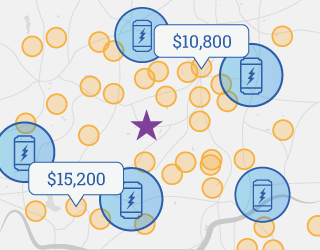Gel batteries are a type of lead-acid battery that, in certain cases, can be a solid choice as an energy backup system or paired with solar panels. In this article, we’ll discuss some of the differentiating factors between gel batteries and other energy storage options, and the best use-cases for this technology.
What are gel batteries? How do they work?
A gel battery is a type of lead-acid battery. The major difference between gel batteries and other lead-acid options (and where they get their name from) is the material inside: a gel battery includes silica in its inner electrolyte mixture, which creates a gel-like substance. We’ll spare you from the extensive details of everything that differentiates these two battery chemistries from one another, but it’s important to know that the gel batteries allow for more power to be packed into a lead-acid battery housing.
Gel batteries vs. standard lead-acid batteries
Gel batteries are a type of sealed lead-acid batteries, much like absorbed glass mat (AGM) batteries. Because they are “sealed”, gel batteries don’t need their water levels checked and monitored like standard lead-acid options, nor do they expel gas. These factors generally make gel batteries a safer option than traditional lead-acid options, as they’re more of a “set it and forget it” product.
Since gel batteries have a different interior consistency, you can install them in a variety of orientations and positions. Combining this with the lower/nonexistent fumes emitted during operation makes gel batteries applicable in situations where ventilation is limited. You can often find gel batteries used for RVs and motorized wheelchairs, as a few examples.
If you’re curious how standard lead-acid batteries generally compare to lithium-ion options, you can check out our lead-acid vs. lithium-ion batteries overview.
Gel batteries vs. AGM batteries
Both gel batteries and AGM batteries are sealed lead-acid batteries with many similar applications. A major difference between the two technologies is their charge rates – AGM batteries are better at handling higher charge and discharge rates than their gel counterparts. In general, gel batteries are still a solid option for projects that involve very slow, deep discharge. Additionally, gel batteries tend to last longer in high temperatures, which is another reason why gel technology performs better in poorly ventilated spots.
Can you pair gel batteries with solar panels?
Like other lead-acid battery options, gel battery products can be a solid choice to pair with a solar panel system in select cases. However, for most residential solar panel installations, you’ll want to explore lithium-ion batteries like the Tesla Powerwall or LG Chem RESU to keep up with the high energy input from a solar panel system, as well as the high energy demands of a household.
Gel batteries, like AGM batteries, can be particularly useful for small, off-grid solar systems. For example, a remote cabin with low energy demand and a small system on the roof may be the perfect candidate for a gel or AGM battery bank. No maintenance is needed, and the relatively low upfront cost of lead-acid batteries in general makes gel batteries ideal for these smaller, off-grid setups. However, of all the types of lead-acid batteries, gel batteries are often the most expensive.
Compare your solar-plus-storage options on EnergySage
Not sure how to start comparing your solar and storage options? A qualified EnergySage-approved company can give you the best recommendation about the right battery system and other energy storage options for your unique setup. If you are interested in receiving competing installation quotes for solar and energy storage options from local installers near you, simply join the EnergySage Solar Marketplace today.






